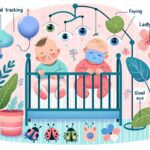Visual tracking is a crucial developmental milestone for babies, allowing them to follow moving objects with their eyes. This skill is fundamental for their overall development, including learning, coordination, and future reading abilities. As new parents, understanding and supporting your baby’s visual tracking development can play a significant role in their growth.
What is Visual Tracking?
Visual tracking refers to the ability to smoothly and accurately follow moving objects with the eyes. This skill is essential for babies as it develops from birth through the first few months of life. It lays the foundation for more complex visual abilities and is closely linked to other developmental milestones.
Effective visual tracking supports cognitive development, hand-eye coordination, and social engagement. It enables babies to explore their environment, recognize familiar faces, and interact with the world around them. For more information on developmental milestones, you may find this article on developmental milestones helpful.
Why is Visual Tracking Important for Babies?
Visual tracking plays a pivotal role in a baby’s early development. It is not just about following objects with their eyes; it’s about processing information, learning patterns, and developing spatial awareness. These skills are critical for later achievements, such as reading, writing, and sports.
Moreover, visual tracking is often one of the first ways babies learn to engage with their environment. It allows them to connect with their caregivers, fostering bonding and emotional security. Recognizing the importance of visual tracking can help parents and caregivers provide targeted support for their baby’s growth. For insights into bonding with your baby, consider reading about bonding.
How to Support Your Baby’s Visual Tracking Development
Encouraging visual tracking development in babies can be both fun and rewarding. Simple activities like moving a colorful toy back and forth in front of their face can significantly enhance their tracking abilities. It’s crucial to start these exercises early on, as visual tracking develops rapidly in the first six months.
Another effective method is to use high-contrast objects or toys. Babies prefer to look at high-contrast colors, making black and white patterns especially appealing. This preference makes such toys effective tools for stimulating visual tracking. Additionally, engaging in face-to-face interaction with your baby, such as making facial expressions and moving your head slowly from side to side, can also boost their visual tracking skills. For more tips on nurturing your baby’s development, our article on cognitive development may be of interest.
Visual Tracking and Recognizing Potential Issues
While visual tracking is a natural process for most babies, some may experience difficulties. Early detection of potential issues is key to providing the necessary support and intervention. Signs that may indicate a problem with visual tracking include a noticeable lag in following objects, difficulty maintaining eye contact, or eyes that seem to wander or do not align properly.
If you observe any of these signs, it’s essential to consult with a pediatrician or a specialist in pediatric eye care. They can assess your baby’s visual development and suggest appropriate steps or interventions if needed. It’s also useful to familiarize yourself with conditions that might affect visual development, such as strabismus or retinopathy of prematurity.
Tips for Creating a Visually Stimulating Environment
Creating a visually stimulating environment is another way to support your baby’s visual tracking and overall development. This can include decorating their nursery with high-contrast wall decals, providing a variety of visually interesting toys, and ensuring they have opportunities to explore different patterns and textures.
Outdoor activities are also beneficial. Taking your baby for walks and allowing them to experience the natural environment can help stimulate their visual tracking. The movement of leaves, the contrast between sky and trees, and the variety of colors and shapes all contribute to visual development. Remember, every interaction is an opportunity for learning and development. For more ideas on activities, explore our resources on motor skills development.
In conclusion, visual tracking is a fundamental aspect of a baby’s early development, influencing cognitive abilities, motor skills, and social engagement. By understanding its importance, recognizing signs of potential issues, and actively supporting your baby’s visual development, you can help lay the foundation for their future learning and growth.













